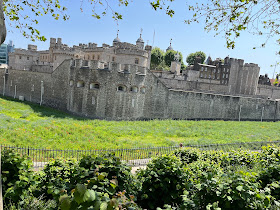 Northeast England is where you'll find
Wallsend (literally, "the wall's end," referencing Hadrian's Wall)
and the ancient Roman fort of Segedunum. Taking a trip through time, your visit
to Segedunum is greeted in two languages: English and Latin. Every sign is in
both, which is fantastic for students studying the language!
Northeast England is where you'll find
Wallsend (literally, "the wall's end," referencing Hadrian's Wall)
and the ancient Roman fort of Segedunum. Taking a trip through time, your visit
to Segedunum is greeted in two languages: English and Latin. Every sign is in
both, which is fantastic for students studying the language!This fort was used as a garrison for about
three hundred years, up to the end of the 4th century. Unlike the
other forts along Hadrian's
 Around the year 400, the fort was abandoned when Roman troops were
recalled to the empire. The area was used as farmland until the mid 18th
century, when it began to transform into the industrial town that it is today. Today, Segedunum is the most hi
Around the year 400, the fort was abandoned when Roman troops were
recalled to the empire. The area was used as farmland until the mid 18th
century, when it began to transform into the industrial town that it is today. Today, Segedunum is the most hi
Explore the art, history, geography, food, and culture of England in this cross-curricular unit study….perfect for families getting ready to travel abroad or folks who want to travel via unit studies! Each stop along the roadschooling trip covers a different facet of history and culture with unit information, resources, worksheets, activities, and more...
YES! I want 122 pages of FUN STUDIES!
- o Introduction & Geography of England
- o Portsmouth
- o The Mary Rose & naval archaeology
- o London
- o The British Museum & archaeology
- o The Wallace Collection & medieval history
- o The Tower of London / London Bridge & the Tudors
- o Buckingham Palace & royalty
- o Victoria and Albert Museum & medieval art
- o Thames / Globe Theater & Shakespeare
- o Sherlock Holmes Museum & British Literature
- o Abbey Road & British Invasion
- o Leeds
- o Royal Armouries & middle ages
- o York
- o Jorvik & Vikings
- o York Castle & archaeology
- o Haltwhistle
- o Hadrian’s Wall & ancient Celts
- o Vindolanda & archaeology
- o Alnwick
- o Alnwick Castle & architecture
- o Poison Garden & herbs
- o Barter Books & WW2 history
- o Alnmouth
- o North Sea & train history
- o Newcastle o Segedunum & ancient Romans
- o Tips & Tricks for Travelling in England

.jpg)














